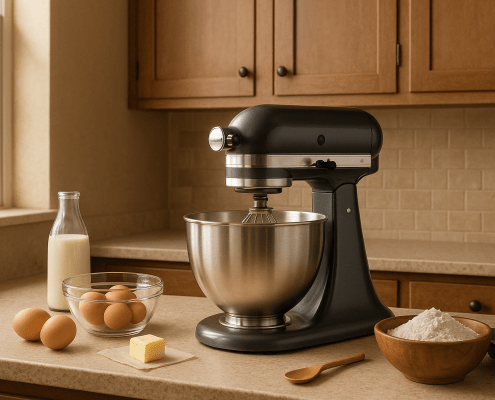What That Clicking Sound in Your KitchenAid Mixer Really Means
Steven E / Wednesday July 9, 2025
Is your KitchenAid stand mixer making a strange clicking sound while you’re whipping up your favorite recipe? That little noise could mean a few different things, and not all of them are serious. Here’s what that clicking sound in your mixer means, and how to figure out if it’s an easy fix or time for a little maintenance.
The information in this article may not apply to your specific appliance model. We recommend consulting your manufacturer’s documentation or contact us with any questions.
Why Is My KitchenAid Mixer Clicking?
When your mixer is working properly, it should run with a smooth hum. A clicking or ticking noise usually signals one of these common problems:
- Worn or broken internal gears.
- Loose attachment hub or bowl.
- Misaligned or over-tightened beaters hitting the bowl.
- Dry or deteriorated grease inside the gearbox.
- Worn or cracked planetary shaft pin.
Some clicking is normal on low speeds (like the sound of the planetary gear’s pin engaging), but loud, persistent clicking, especially if paired with reduced performance or grinding, means it’s time to take a closer look.
Common Causes of Clicking and How to Diagnose Them
Here’s how to figure out what’s making the noise, and what you can do about it.
Loose or Misaligned Beater or Bowl
Sometimes, the simplest cause of a clicking noise is that your bowl or attachment isn’t properly secured.
- With the mixer turned off, check that the bowl is locked securely into place.
- Make sure the flat beater, whisk, or dough hook is firmly installed on the shaft.
- Spin the beater by hand; if it wobbles or lightly hits the bowl at the bottom, it can cause a rhythmic clicking.
Fix: Adjust the bowl height by turning the small adjustment screw (on the hinge for tilt-head models, behind the bowl support for bowl-lift models) until the beater just clears the bowl’s surface.
Worn Gear or Pinion Teeth
Inside your mixer is a set of metal and nylon gears that transfer motor power to the attachments. If one or more teeth are stripped, worn, or broken, they can make a clicking sound as they slip.
Signs:
- Loud clicking under load.
- Intermittent slipping or hesitation while mixing.
- Fine metallic shavings are visible when opening the gearbox.
Fix:
- Unplug the mixer and remove the motor housing cover.
- Inspect the worm gear and pinion gear inside the gearbox.
- If you see missing or damaged teeth, replace the worn gear. (KitchenAid’s worm gear is designed to fail first and is easy to replace.)
- Repack the gearbox with fresh food-grade grease before reassembling.
Worn or Damaged Planetary Shaft Pin
The small pin that holds the planetary assembly (the part that spins at the bottom of the mixer) can wear out, loosen, or break. When it does, the planetary assembly can wobble and click as it spins.
Signs:
- Clicking comes from the very bottom of the mixer.
- The planetary assembly feels loose when wiggled by hand.
Fix:
- Remove the planetary cover (the chrome cap at the bottom).
- Push out the old pin and install a new one.
- Make sure it’s seated snugly before reassembling.
Dried or Degraded Grease
The gears in your mixer are packed with grease, which cushions the teeth and keeps them running quietly. Over time, the grease can dry out or separate, leaving parts unprotected. This can lead to clicking and premature wear.
Signs:
- Clicking or grinding noise at all speeds.
- Visible dark, dry, or separated grease inside the gearbox.
Fix:
- Disassemble the motor housing and gearbox.
- Remove all old grease with a plastic scraper and clean rag.
- Apply a fresh layer of food-grade grease to all moving parts.
- Reassemble and test.
When Is Clicking Normal?
Not all clicking means something’s wrong. On very low speeds, you might hear a faint clicking as the planetary gear’s pin engages; this is normal. Similarly, if your mixer is lightly loaded, the motor may make a mild ticking sound as it adjusts.
If the clicking is loud, irregular, or gets worse under load, however, it’s a clear sign of wear that should be addressed.
Tips to Prevent Clicking and Keep Your Mixer Running Quietly
- Avoid overloading your mixer; use the right speed and batch size for your model.
- Clean and inspect attachments and the bowl after each use.
- Re-grease the gearbox every 3–5 years, depending on use.
- Adjust the bowl-to-beater clearance periodically.
- Store your mixer in a dry, clean place to prevent moisture damage.
Why Fixing It Yourself Is Worthwhile
KitchenAid mixers are designed to be serviceable. Most clicking-related repairs, like replacing the worm gear, shaft pin, or re-greasing, can be done at home with basic tools and affordable parts. Keeping your mixer maintained saves you money and helps preserve an appliance that can last for decades with proper care.
Where To Find Us
If you need any replacement parts for your appliances, you can enter your model number at AppliancePartsPros.com to locate and order them quickly. Most orders arrive in just two business days, and we have tons of great information in our repair help section and YouTube videos to help you troubleshoot.
Stay connected with the latest DIY tips, tutorial videos, and repair guides by following us on Facebook, Instagram, and Twitter. We love hearing about your repair stories and successes. If you need more help or want personalized guidance, feel free to reach out. We’re ready to help you take on your next project with confidence!
With nearly a decade of experience in providing top-notch customer service regarding appliance parts and repair, Steven enjoys sharing practical advice, troubleshooting tips, and interesting information to help readers stay informed.





